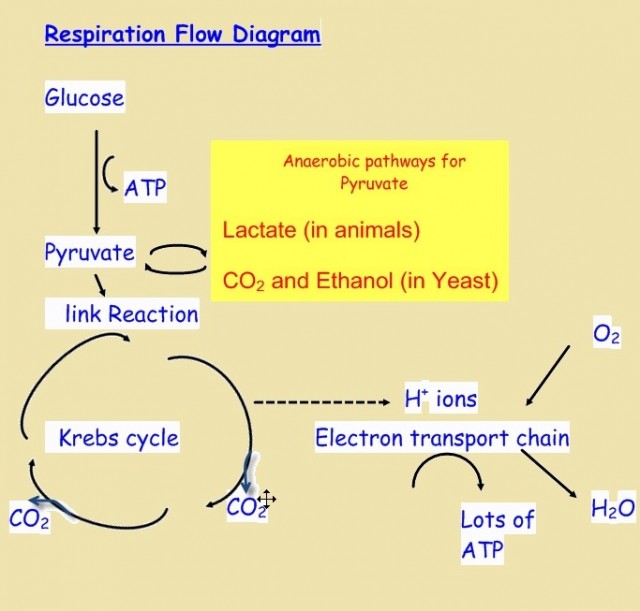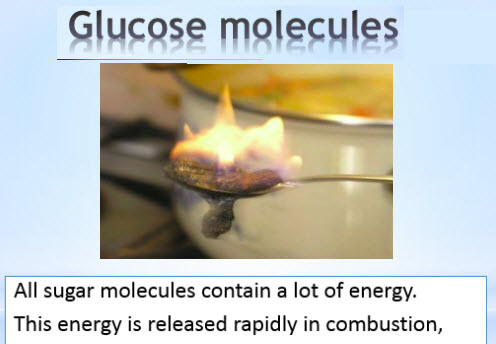Cell Respiration.
 The controlled release of energy from organic compounds in cells
The controlled release of energy from organic compounds in cells
With the smell of caramel from the burning glucose filling the lab, students discuss the need for metabolic pathways in respiration. A card sort activity and discussion will outline the main ideas for SL respiration, and there is a series of true / false statements which help students to make some revision notes.
Lesson Description
Guiding Questions
What is the equation of respiration?
Why does the energy have to be released step by step in cell respiration?
What is the role of ATP?
Activity 1 - Intro to Respiration and Demo of burning sugar
Demo the burning of glucose (see details in the teacher notes at the bottom of the page) and use the powerpoint slides below to discuss the need for a controlled breakdown of glucose in cell respiration. The slides outline the main steps in the cell respiration metabolic pathway.
Activity 2 - Card sorting activity to explain respiration
Cut out the cards on the ![]() Respiration card sort worksheet below and arrange them onto an A3 sheet. Draw arrows and write notes to explain each step in the process.
Respiration card sort worksheet below and arrange them onto an A3 sheet. Draw arrows and write notes to explain each step in the process.
A suggested model answer can be seen below (click the eye icon)
Model answer suggestion fo the Cell Respiration cart sort activity. (Thanks Jake)

For further reinforcement of the main concepts in respiration at SL study the online flashcards below. There are a range of online study mode options in the drop-down menu
Activity 3 - True or False Questions
Select the statements on this ![]() Respiration - true false worksheet. which are true and those which are false?
Respiration - true false worksheet. which are true and those which are false?
Teachers notes
It is important for less able SL students that this lesson doesn't get into too much detail of the molecular structures or the details of mitochondria structure. The IB guide does not require these details at SL.
The converse is true for HL students. This lesson will be a good overview, but the molecular structures are important, as is the structure of the mitochondrion.
The simplest way to manage this in a mixed class is to devote on hour to these basics and then another lesson or two for the HL respiration topic.
Demo of the Combustion of Sugar
Sugar can be burned in an old spoon in the Bunsen flame. It will melt, caramelize and then burn into a black carbon sticky mass. This does demonstrate quite well how unsuitable combustion would be to get the energy out of the sugar in a living cell. You may also point out that the energy is instantly lost to the environment as heat.
This Demo is better than the old spoon technique and a pretty cool trick that may just grab the attention of your students before you hit them with some theory about respiration.
A sugar cube will not burn unless it is first rubbed with ash. Ashes catalyze the burning of sugar and speeds up the combustion reaction. There is some disagreement among chemists about how the ash catalyses the reaction.
Materials:
- · Sugar cubes
- · Bunsen burner or propane torch
- · An old teaspoon or spatula (tongs or tweezers - if you are brave)
- · ashes (from a cigarette or any burned plant material
Safety: Be careful not to burn yourself.
Method:
Rub a sugar cube with ash.
With an old spatula or tongs, hold this cube in a flame (it will burn).
The demonstration is to remind students of the basic equation of respiration, and the aim of respiration, which is to release the energy from the glucose molecules. Burning sugar reaches temperatures which would cause great damage to living cells so this introduces the need for a slower chemical reaction. Breaking the combustion process into a sequence of steps will release the energy more slowly and solves the problem. (It also makes the room smell nice which may have the effect of comforting students who think chemistry is hard.
The Powerpoint slides can be used to revise the equation of respiration and to introduce the details of the steps in cell respiration. The details are simplified, and HL students will need to know more full details later.
It is likely that students will need help with the diagram from their text book & teacher.
The Quizlet cards activity could be used as an extension activity, it is not essential to the flow of the lesson.
This lesson could be followed by the ![]() Respiration experiment with maggots and respirometers.
Respiration experiment with maggots and respirometers.

 IB Docs (2) Team
IB Docs (2) Team
